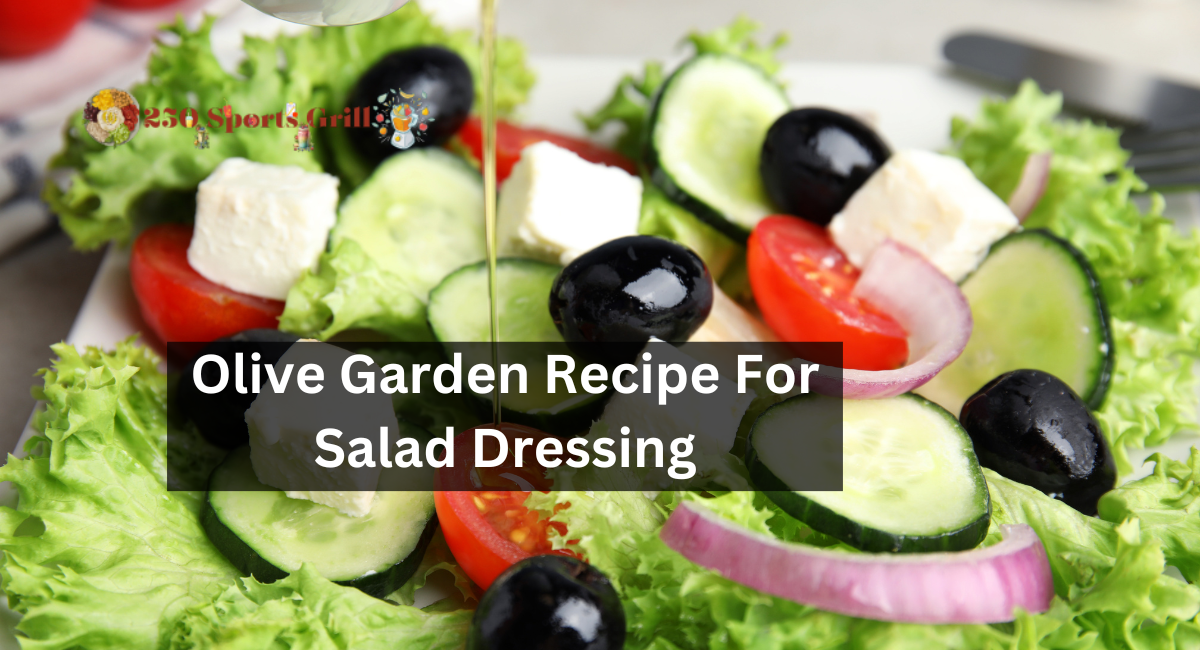In addition to its exquisite Italian fare, The Olive Garden is widely recognized for its enticing house salad and vinaigrette. The signature salad vinaigrette of the restaurant has won over the affections and palates of numerous patrons. People’s eagerness to replicate this salad dressing at home is unsurprising, given its exquisite harmony of flavors. By delving into the intricacies of the Olive Garden salad dressing recipe, this article aims to provide readers with the means to replicate the restaurant’s salad experience in the convenience of their kitchens. Prepare to embark on a gustatory journey as you introduce the renowned salad dressing from Olive Garden to your dining experience.
Olive Garden Dressing For Salad
This recipe for olive garden salad dressing is a staple among Italian Americans. Embrace the delectable, zesty flavors that you have come to adore in this straightforward vinaigrette that can be prepared at home.
Time
- Prep: 10 minutes
- Total: 10 minutes
Ingredients
- 1/2 cup olive oil
- 1/4 cup mayo
- 3 tablespoons white vinegar
- 1/2 tablespoon granulated sugar
- 1 teaspoon italian seasoning
- 1/2 teaspoon onion powder
- 1/2 teaspoon garlic powder
- 2 tablespoons freshly grated parmesan cheese
- 1/4 teaspoon salt
- pepper to taste
Instructions
- Whisk together all ingredients in a prep basin or shake vigorously in a jar until thoroughly combined. If necessary, modify the flavor by adding additional sugar or vinegar.
- Refrigerate the vinaigrette in an airtight container for five to seven days. Shake vigorously before use, as separation is inevitable.
Variations And Substitutions
If desired, substitute a packet of Italian dressing blend for the specified quantities of garlic powder, onion powder, and herbs. However, these frequently contain sugar, so if you choose that route, you may not want to add any more.
Consider substituting fresh herbs for the existing herb mélange. Remember that the more you alter it, the less similar the flavor will be to the Olive Garden version. That, too, is fine!
I suggest following the mayonnaise’s instructions for optimal flavor and texture. Others have substituted yogurt or sour cream for it, but the result will be distinctly different in flavor.
What To Serve With This Dressing
To make it a full meal, put it in a salad and serve it with comfort foods like Baked Ziti, Spaghetti and Meatballs, or these Spinach and Ricotta Stuffed Shells.
Enhance a salad with seared chicken and serve it alongside garlic bread, a slice of crusty bread, or olive Garden breadsticks for a light lunch.
Additionally, it can be utilized as a vegetable dip for a speedy refreshment.
Leftovers And Storage
Refrigerate this dressing for five to seven days in a securely sealed container.
It is not advisable to retain an assembled salad for an extended duration. Instead, simply refrigerate the individual components separately and reassemble a salad using any remaining dressing at your convenience.
Health Benefits Of Eating Olive Garden Salad Dressing
In moderation, Olive Garden’s salad dressing, renowned for its robust and delectable taste, may provide certain health advantages. The following are some prospective health advantages of consuming Olive Garden salad dressing:
Healthy Fats: Olive oil is the typical ingredient in Olive Garden salad dressing. Olive oil contains monounsaturated lipids, which are fats beneficial to the heart. When consumed as part of a well-balanced diet, these lipids can lower cholesterol levels and thereby reduce the risk of cardiovascular disease.
Rich in Antioxidants: Olive oil is a great source of antioxidants, including vitamin E and polyphenols. Antioxidants aid in the defense of cells against oxidative harm inflicted by free radicals. Antioxidant consumption may benefit one’s health and well-being as a whole.
Anti-Inflammatory Properties: The anti-inflammatory properties of olive oil and, consequently, salad dressings formulated with it have been documented. Chronic inflammation has been associated with a range of health complications, such as cardiovascular disease, diabetes, and certain types of cancer. The reduction of inflammation may yield beneficial health outcomes.
Enhanced Nutrient Absorption: Incorporating a trace quantity of beneficial fat, such as that present in Olive Garden salad dressing, into one’s salad can augment the assimilation of fat-soluble vitamins (A, D, E, and K) derived from the salad vegetables.
Satiety: The inclusion of a flavorful vinaigrette in a salad has the potential to improve its flavor and increase its overall satiety, which may result in a reduced caloric intake. An appropriately garnished salad can enhance satiety and promote overall satisfaction with one’s meal.
Encourages Vegetable Consumption: Advocates for Increased Vegetable Ingestion Olive Garden salad dressing’s flavor and aroma may motivate individuals to consume additional salads and vegetables. Various fresh vegetables must be consumed to maintain optimal health, as they contain vital vitamins, minerals, and dietary fiber.
Recreating the Olive Garden experience at home is a delectable one, and attaining expertise in their signature salad dressing is a noteworthy culinary accomplishment deserving of celebration. By following the instructions in this article, one can produce a vinaigrette that perfectly captures the essence of the renowned salad from Olive Garden. Whether one is preparing for an elegant supper or simply yearns for the flavor profile of their preferred eatery, this recipe will assist them in appreciating the renowned, invigorating aromas that comprise Olive Garden’s salad dressing. Thus, assemble the necessary components and embark on an exploration of the realm of homemade Olive Garden salad dressing, wherein each morsel will transport you to the essence of Italy.
Thanks for visiting our site hope you like it ..
